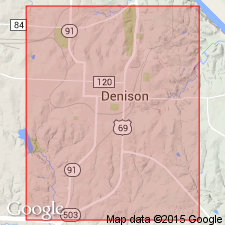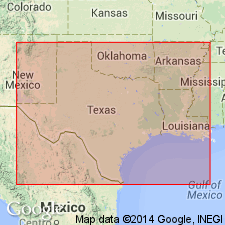
- Usage in publication:
-
- Denison beds
- Modifications:
-
- Original reference
- Dominant lithology:
-
- Clay
- Lime
- Sand
- AAPG geologic province:
-
- South Oklahoma folded belt
Summary:
Pg. 290. Denison beds. Alternations of clay, lime, and sand, 100 feet thick. Top formation of Washita division. Overlies Vola limestone [not †Vola limestone] and underlies Lower Cross Timber beds [Woodbine sand]. [Age is Early Cretaceous (Comanche).]
[Named from exposures at Denison, Grayson Co., northeastern TX.]
Source: US geologic names lexicon (USGS Bull. 896, p. 596-597).

- Usage in publication:
-
- Denison beds
- Modifications:
-
- Revised
- AAPG geologic province:
-
- Fort Worth syncline
- South Oklahoma folded belt
Summary:
Pg. 504, 517. Denison beds. Laminated arenaceous clays at base, grading upward into sandy clays and occasional limestones, the chalky element of all the underlying Comanche series having finally disappeared. In Grayson, Cooke, and Denton Counties, northeastern Texas, and in Indian Territory [southern Oklahoma], is divisible into (ascending): (1) Blue marly clay, weathering brown, with occasional layers of immense, rounded fissile indurations, generally of brown color; (2) more sandy and ferruginous beds, oxidizing into ironstone and almost indistinguishable from Dakota sandstones; (3) impure yellow limestone underlying Main Street in Denison. Underlies, unconformably, Dakota sandstones [Woodbine sand] and overlies Fort Worth limestone. Top formation of Washita division. Age is Early Cretaceous (Comanche).
[GNC remark (ca. 1936): This is present generally accepted definition of Denison formation (Washita group).]
Source: US geologic names lexicon (USGS Bull. 896, p. 596-597).
For more information, please contact Nancy Stamm, Geologic Names Committee Secretary.
Asterisk (*) indicates published by U.S. Geological Survey authors.
"No current usage" (†) implies that a name has been abandoned or has fallen into disuse. Former usage and, if known, replacement name given in parentheses ( ).
Slash (/) indicates name conflicts with nomenclatural guidelines (CSN, 1933; ACSN, 1961, 1970; NACSN, 1983, 2005, 2021). May be explained within brackets ([ ]).

